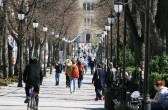 Philadelphia, Pa.My wife and I no longer own (better – make loan payments) on a car. I would like to claim that an auto-less existence results from a principled stand against fossil fuels. As guilty as I am (a la Wendell Berry) for soiling the planet with carbon emissions and as much as I would like to restore my innocence, the decision to abandon a car has more to do with being downsized than with ideas and their consequences.
Philadelphia, Pa.My wife and I no longer own (better – make loan payments) on a car. I would like to claim that an auto-less existence results from a principled stand against fossil fuels. As guilty as I am (a la Wendell Berry) for soiling the planet with carbon emissions and as much as I would like to restore my innocence, the decision to abandon a car has more to do with being downsized than with ideas and their consequences.
To adjust to economic realities, my wife and I also moved from the leafy neighborhood of Chestnut Hill into Center City, Philadelphia. Urban centers, especially in the Northeast, are the rare places that make life possible without a car. I have agrarian friends in rural Virginia who need to drive their pick-up trucks at least a mile just to pick up the mail. In Philadelphia, car rentals are possible by the hour. But the city’s public transportation system is very good even if quirky and still in need of some upgrades. And if residents are willing to use their solar-powered bodies to make up the difference between the buildings they want to enter and the nearest train or subway station, they can – with the help of SEPTA – go almost anywhere in the Delaware Valley.
So instead of driving, my wife and I walk – a lot. I even walk to purchase beer, which is something of a nuisance in Pennsylvania where cases are much cheaper (per bottle) than six-packs from the local package store. The Pennsylvania Liquor Control Board – a Prohibition-Era agency – still controls the sale and distribution of wine and hard liquor. Beer distributors sell cases. Bars and some delicatessens sell six packs. This means I need to walk a little more than a mile each way to buy a case from one of the city’s very good micro-breweries. (The Hart favorite these days is Yard’s IPA.) But a two-wheeled shopping cart makes this a fairly easy outing as long as the weather cooperates.
Less cooperative are the automobiles that cities allow us to give up. Sidewalks are increasingly crowded with hot dog and newspaper vendors, as well as restaurants that turn open sidewalks into outdoor cafes. Sidewalks also become the favorite site for renovation and construction projects. In all of these cases, city officials would never countenance taking away a lane of traffic. Instead, they pass the pain along to pedestrians. In our section of downtown Philadelphia, we needed to cross the street twice to avoid construction projects on either approach to our high-rise building.
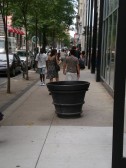 When you consider the number of pedestrians competing for sidewalk space compared to the number of car occupants, the fight seems rigged. The average sidewalk is ten feet wide. That means that roughly four people – more likely three of polite dispositions — can pass comfortably. The average two-lane street is seventeen feet wide. At best, the average car is carrying two occupants. Which means that about the same number (four) of car occupants as pedestrians may pass safely down a space almost twice as large as the sidewalk. On our street in Philadelphia, not one of the busiest for traffic, the pedestrians are likely four times the number of car occupants on the average block. That means that people in cars take up a disproportionate amount of space. Does this give me license to hate car drivers? I know what Jesus would do: hate the car, love the car driver.
When you consider the number of pedestrians competing for sidewalk space compared to the number of car occupants, the fight seems rigged. The average sidewalk is ten feet wide. That means that roughly four people – more likely three of polite dispositions — can pass comfortably. The average two-lane street is seventeen feet wide. At best, the average car is carrying two occupants. Which means that about the same number (four) of car occupants as pedestrians may pass safely down a space almost twice as large as the sidewalk. On our street in Philadelphia, not one of the busiest for traffic, the pedestrians are likely four times the number of car occupants on the average block. That means that people in cars take up a disproportionate amount of space. Does this give me license to hate car drivers? I know what Jesus would do: hate the car, love the car driver.
One of my favorite authors shared these sentiments when he lived in Center City and fought proposed jaywalking legislation. That man is J. Gresham Machen who moved to Philadelphia in 1929 from Princeton to start a seminary that would rival the Presbyterian one in Princeton that he suspected was guilty of bad Calvinism (yes, there is a good variety). Machen enjoyed walking, and was especially fond of reading pocket-sized editions of the Loeb Classics while he walked to and from class. The thought of having to wait for cars was anathema.
He also had a point when he wrote a letter to one of the city newspapers – he also testified before city council – about the mind set of city planners who were opening up Philadelphia to automobiles and their drivers.
. . . I am dead opposed to subjecting a whole city because of the comparatively few incautious people to a treadmill regime like that which prevails in Western cities. I resent such a regime for myself. I have tried it, and I know that it prevent me from the best, and simplest pleasure that a man can have, which is walking. But I resent it particularly because it is a discrimination against the poor and in favor of the rich.
That brings us to the real purpose of these laws, which is not that pedestrians should be spared injury but that motorists should be spared a little inconvenience. I drive a car from the driver’s point of view. I know how trifling is the inconvenience which is saved thus at the expense of the liberty of the poorer people in the community. Indeed, I do not believe that in the long run it is for the benefit even of the motorist. I think it is a dreadful thing to encourage in the motorist’s mind, as these laws unquestionably do, the notion that he is running on something like a railroad track cleared for his special benefit.
I am prone to similar resentments when I see the way that business owners, city officials, policies, and laws give more consideration to drivers than pedestrians. (Pedestrians themselves are not blameless when it comes to provoking frustration in other pedestrians – a subject for another post.) None of this is so bad that I’d prefer to live somewhere else. The advantages of living without a car are greater than the annoyance of negotiating their presence. But cities would be grand if city governments prohibited cars.
Then again, I would be glad to make room for a car like this. 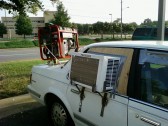


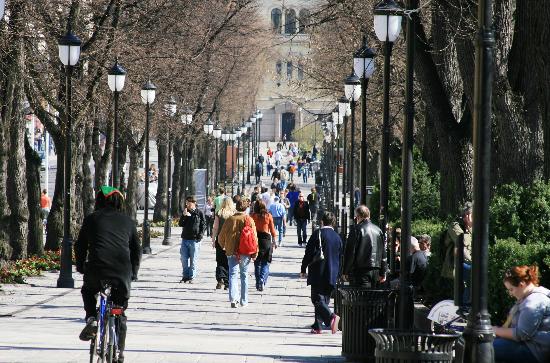
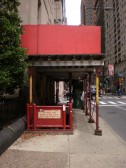










My ’94 Nissan Sentra beater has been without A/C since ’06. I have been inspired.
Mr Hart – You do not mention bicycles, the riders of which live in that dangerous and uneasy place between pedestrians and car drivers. Philly and other northeastern cities are making significant (if overdue) investments in helping bikers share the road with cars and this is making a “third way” of transit possible–not just for pleasure riding but for errands, shopping, getting kids to school, etc.
I have spent significant time in Philadelphia over the past four summers and the change has been encouraging. However, I echo Machen’s comment:
“That brings us to the real purpose of these laws, which is not that pedestrians should be spared injury but that motorists should be spared a little inconvenience.”
Add bicycles to his comment about pedestrians and he has described the challenge in ALL American cities. In my little (western) town, (which is a “platinum” biking city) we have been working hard to make a major artery more “bikeable”. The resistance has been intense. At a recent hearing on assessing the impact of proposed changes we suggested that evaluating “traffic flow” into downtown (the shopping district–where business owners have fought the change) should include “walkers” and “bikers” not just number of automobiles. Our suggestion was met with some incomprehension. The reality is the very means of assessing the impact of road redesign (though I think this is changing) is based on the narrow criterion of what it will mean for the ability of CARS to get into downtown… We have some work to do.
It has always seemed to me that automobiles and the big city were a miserable mixture. Nevertheless, if I put myself in your place I would have a hard time getting rid of my car. Perhaps it is being raised in the midwest, maybe it is too many sci fi books or documentaries of world war II, but the idea of being trapped in a big city during a catatrophic event scares the dickens out of me. I realize it might be a myth or fantasy that during a plague, rebellion, riot, food/water shortage or alien invasion, that I would be able to jump into the old chevy and drive out of dangers way and perhaps watch the collapse of civilization from afar. Nevertheless, it seems to me that I need to be ready to get out of Dodge, and the freedom to run that the automobile symbolizes, though perhaps no longer realistic, is a necessary part of my sense of well being.
DG: Calvinism has just risen a notch or two–at least. May the triune God bless the city where all the brudders love each udder.
This is great. In a week or so I am switching to biking about 95% of the time for my transportation. As with you, it’s not exactly high-minded ideals. Convenience, rather–I am moving to within a 10-15 minute bike ride of work, school, and gym. No reason to drive. Though one reason among many for driving is to eliminate the wasted time, gasoline, and miles of forty minutes of driving.
I’ve recently been reading a blog by a Tucson Bike Lawyer. One of his largest categories is “imminent death of car-based culture.” I like that. Another consistent topic is what Robb brought up–the viability of bicycle transportation, which in most places is considered “in between.” Tucson is a Gold-rated bicycle city, but even so there remains an attitude that bicycling should stay off the roads and stick to recreation. This particular lawyer is liberal, but I love how these kinds of topics reveal the poverty and exhaustion of current political discourse.
Speaking of which, Chestnut Hill! John Lukacs!
Walking was once normal in the countryside too. One of the side effect of the car was the destruction of rural businesses within walking and horse distance of many areas in the east. My grandfather (died 1960) never owned a car. He could easily walk or leisurely drive a horse to three country stores, a diner, a grange hall, and five churches (all Presbyterian) in our rural Western Pennsylvania Township. The Country stores at the time fronted for catalogues and/or carried more stuff. I remember one had lawn mowers hanging on wire from the ceiling. Once country people could drive, the 5-12 miles to towns became easy, and the rural stores vanished (or at least cut back on inventory)
It is an education to look at old county maps and see the diversity of business that once flourished in my Township, which is now essentially a bedroom community with some farms and a bit of mining.
Walking is the sport of pilgrims, and this one credits its regimen with being the one activity that has corrected other (ahem) less disciplined behaviors and guilty pleasures to earn those coveted numbers: 120/80 and less-than-180; the health gods do back me up here. And I should hope it would raise Calvinism’s stock to some around here to realize that the other pilgrim sport, “a good walk spoiled,” was invented in the land of Presbyterians.
I similarly was forced into a non-car existence (my car died, and being a grad student not close to finishing, I couldn’t replace it, so I used the tax rebate from a few years back and bought a solid commuter bike), but I now love it. I live in a mid-western university town with good public transit and very bikeable roads. There are times when it’s a bit inconvenient (like when roads are icy), but it actually has been very useful for helping me prioritize what is worth spending time and energy on, since it’s usually my own energy that is used to get anywhere. I’m close to finishing up, and hope to find a job in a location where I can similarly live car-free.
I do admit that it can be very hard sometimes to love the car driver, especially when they yell taunts at you for no particular reason, or when they don’t bother to notice you even when you’re wearing a brightly-colored shirt and then almost run you over, or when your friends think it’s OK to dismiss your worries about bikes being hit by cars because there was once this time when a dumb cyclist cut ran a stop sign in front of them, which apparently gives them license to muscle cyclists off the road with their huge metal exoskeletons.
Jaywalking laws are definitely counterproductive. As a lifelong biker and pedestrian (haven’t driven regularly since 1986) I’ve figured out a few things about Newton’s laws.
On most streets it’s safer to cross in the middle of the block, because you can see all the cars that might hit you, and the cars are moving at steady speeds. (There are valid exceptions to this rule.)
A couple years ago I decided for some reason to follow the laws, cross only at corners … and almost immediately got slammed by a young idiot driving his mom’s SUV and cell-phoning his girlfriend. After recovering, I went back to my old mid-block habits.
Well don’t this post just warm my Presbyterian heart here in Atlanta, the car capital of the South!
Comments are closed.